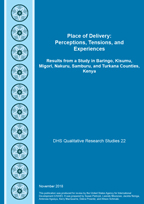- PUBLICATIONS
- JOURNAL ARTICLES
- ACCESS PUBLICATIONS
Publications Summary
- Document Type
- Qualitative Research Studies
- Publication Topic(s)
- Maternal Health
- Country(s)
- Kenya
- Survey
- Kenya DHS, 2014
- Language
- English
- Recommended Citation
- Pietrzyk, Susan, Lwendo Moonzwe, Jacinta Nzinga, Ambrose Agweyu, Kerry L. D. MacQuarrie, Debra Prosnitz, and Allison Schmale. 2018. Place of Delivery: Perceptions, Tensions, and Experiences: Results from a Study in Baringo, Kisumu, Migori, Nakuru, Samburu, and Turkana Counties, Kenya. DHS Qualitative Research Studies No. 22. Rockville, Maryland, USA: ICF.
- Download Citation
- RIS format / Text format / Endnote format
- Publication Date
- November 2018
- Publication ID
- QRS22
Download
 Place of Delivery: Perceptions, Tensions, and Experiences (PDF, 3403K)
Place of Delivery: Perceptions, Tensions, and Experiences (PDF, 3403K)
 Place of Delivery: Perceptions, Tensions, and Experiences - Results from a Six-County Qualitative Study in Kenya (Analysis Brief)
Place of Delivery: Perceptions, Tensions, and Experiences - Results from a Six-County Qualitative Study in Kenya (Analysis Brief)
Download this publication
Associated publication(s):
